We Plead Guilty to Loving These Movies!
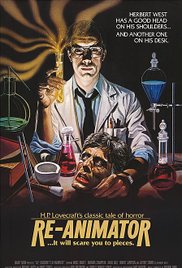 What’s the movie that you love that always gets the response, “Really? That one?” Did you think Chappie was thought provoking or After Earth was exhilarating or maybe you’re the one person that gave The Great Wall two thumbs up. Sometimes we don’t like admitting that we enjoy these movies, they make conversations awkward. It can be especially uncomfortable when you are a “film critic”. For example, I totally lost film cred when I mentioned that The Godfather: Part III is my favorite in the trilogy. And yep, right there, a few of you just gave me a raised eyebrow or shook your noggins. There’s this cringe of shame or doubt when that conversation happens and I instantly want to talk about some French Nouveau film to get those points back. I’m not talking about cult favorites that are labeled “so bad they’re good.” This is not Starship Troopers territory. This is more M. Night Shyamalan Lady In The Water turf, just bad, but for some reason you love it. Call it a guilty pleasure, a sentimental favorite or blame it on nostalgia, we all enjoy a terrible movie from time to time. Woody Allen said it best, “The heart wants what the heart wants.”
What’s the movie that you love that always gets the response, “Really? That one?” Did you think Chappie was thought provoking or After Earth was exhilarating or maybe you’re the one person that gave The Great Wall two thumbs up. Sometimes we don’t like admitting that we enjoy these movies, they make conversations awkward. It can be especially uncomfortable when you are a “film critic”. For example, I totally lost film cred when I mentioned that The Godfather: Part III is my favorite in the trilogy. And yep, right there, a few of you just gave me a raised eyebrow or shook your noggins. There’s this cringe of shame or doubt when that conversation happens and I instantly want to talk about some French Nouveau film to get those points back. I’m not talking about cult favorites that are labeled “so bad they’re good.” This is not Starship Troopers territory. This is more M. Night Shyamalan Lady In The Water turf, just bad, but for some reason you love it. Call it a guilty pleasure, a sentimental favorite or blame it on nostalgia, we all enjoy a terrible movie from time to time. Woody Allen said it best, “The heart wants what the heart wants.”
We can confess, get everything out in the open and instead of shame and doubt we can find confidence and pure joy in the community we all share.
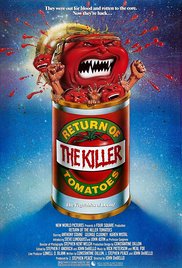 When Jim asked what I wanted to do for July’s Film Admissions I couldn’t stop thinking about the word “admit”. We’ve admitted to big films over the past two years that were for multiple reasons overlooked. But instead of a missed masterpiece what if it’s a film that should have been ignored. What a fun opportunity to write a review and instead of being critical of all the missteps we can cheer on a favorite dud and sing the praises of a movie that probably doesn’t get that much love. We can confess, get everything out in the open and instead of shame and doubt we can find confidence and pure joy in the community we all share. These are ZekeFilm’s “Guilty Pleasure” Film Admissions… what’s yours?
When Jim asked what I wanted to do for July’s Film Admissions I couldn’t stop thinking about the word “admit”. We’ve admitted to big films over the past two years that were for multiple reasons overlooked. But instead of a missed masterpiece what if it’s a film that should have been ignored. What a fun opportunity to write a review and instead of being critical of all the missteps we can cheer on a favorite dud and sing the praises of a movie that probably doesn’t get that much love. We can confess, get everything out in the open and instead of shame and doubt we can find confidence and pure joy in the community we all share. These are ZekeFilm’s “Guilty Pleasure” Film Admissions… what’s yours?
Foolin’ Around
(1980; 20th Century Fox; dir: Richard T. Heffron)
by Dean Treadway
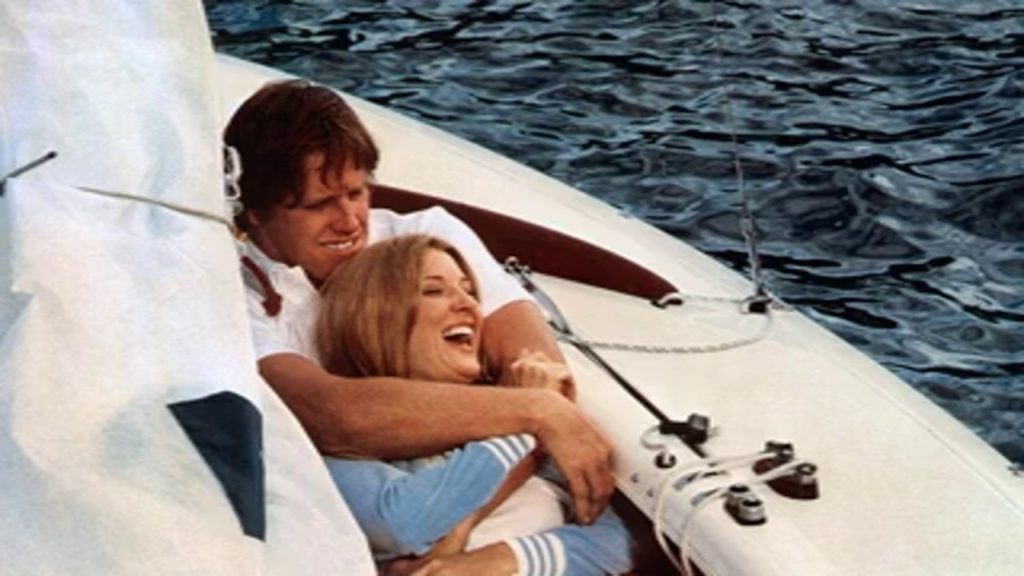
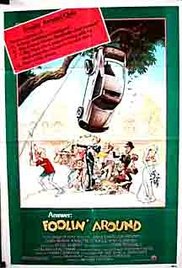 I’ve long had a term for breezy, funny movies that make you happy even if they sometimes insult your intelligence: “Saturday Afternoon” movies. All the films I apply this term to have an inimitable lilt to them, and even if you don’t see them on a Saturday afternoon, they give you the sense that they’d be justly seen at such time, followed by maybe a trip to the ice cream shop. They’re not demanding, but they’re not entirely dumb either, and they have to sport a certain sunny patina. For me, one of the ultimate “Saturday Afternoon” movies looked like a waste of time when I first saw its ridiculous title: Foolin’ Around.
I’ve long had a term for breezy, funny movies that make you happy even if they sometimes insult your intelligence: “Saturday Afternoon” movies. All the films I apply this term to have an inimitable lilt to them, and even if you don’t see them on a Saturday afternoon, they give you the sense that they’d be justly seen at such time, followed by maybe a trip to the ice cream shop. They’re not demanding, but they’re not entirely dumb either, and they have to sport a certain sunny patina. For me, one of the ultimate “Saturday Afternoon” movies looked like a waste of time when I first saw its ridiculous title: Foolin’ Around.
Now, nearly 40 years after its release, I’ve seen few internet bloggers writing about Foolin’ Around (no surprise there, really, since it’s never been offered on DVD or Blu-Ray). But back in 1981 or so, I was quite smitten with HBO, and would watch anything they showed. And I’m glad because it’s there that I discovered this ungainly li’l rom-com charmer centered in on drawling Oklahoma architecture student Gary Busey as he arrives at the University of Minnesota. After getting ripped off by a jerk selling outdated school books (William H. Macy, in his feature debut), he dives into a paying gig as a research subject for a silly psychology experiment that goes awry (in the first of a few embarrassingly goofy scenes).
Rich girl psych student Annette O’ Toole is the one conducting the experiment and thus connects with Busey’s genial humor and kind heart. They swiftly fall for each other, but she’s engaged to ultra-blonde asshole John Calvin. What’s more, her father is architecture mogul Eddie Albert, and her mother is shrewish Cloris Leachman, who adores the bleachy-haired nitwit O’Toole’s betrothed to, while even-keeled Albert despises the very sight of the guy. (Leachman, meanwhile, is having an affair with her creepo European butler, oddly played by Tony Randall; despite her sharp comedy chops, Leachman never gets a laugh in the movie, which is a disappointment). So Foolin’ Around basically turns into an off-brand version of The Graduate, where it’s up to Busey to disrupt the inevitable don’t-do-it wedding scene.
The fact that Busey and O’Toole really sell the central romance makes Foolin’ Around absolutely worth seeing.
I know it sounds like I hate this picture, but I don’t, yet it snugly fits into my “guilty pleasures” file. Still, after each viewing, I always end up smiling, so I don’t know why I should feel so guilty. Roger Ebert, meanwhile, called it a “dimwitted, old-fashioned comedy that’s sort of inspired by old Disney movies and halfway similar to 1940s rah-rah college comedies, and directed and edited with such a puzzling lack of tempo that none of the material ever quite seems in focus.”
This all may be true and yet, despite such deficits, I cherish Gary Busey’s aw-shucks style, with his homey little asides that feel like sweet improvisations, while the achingly pretty, red-haired Annette O’Toole takes a convincing shine to Busey (and the camera), making the love story believable–quite a feat, with that lumbering, big-toothed lunk in the lead (O’Toole performed a similar function in a much better movie, 1978’s Robbie Benson college basketball vehicle One on One). Veteran character actor Eddie Albert had been playing bad guys all throughout the ’70s in movies like The Longest Yard and in his Oscar-nominated role as Cybill Shepard’s overly-protective father in The Heartbreak Kid, but old-pro TV-movie director Richard T. Heffron had sense enough to cast Albert against type here. His chemistry with Busey really pops–they have a particularly terrific scene together on the top of an in-progress building, where Albert places Busey’s heirloom engagement ring on the tip of a towering steel girder to test the dude’s commitment to his daughter.
The fact that Busey and O’Toole generously sell the central romance makes Foolin’ Around absolutely worth seeing. The film concludes with a wacky but genuinely exciting chase scene with Busey, trying to get to the church on time, being pursued by a couple of hired thugs who’ve commandeered a weiner-mobile, as Busey is caught in the bucket of an electrical work truck (lots of impressive stunt work here, and we haven’t even gotten to the hang-gliding scene). Enhancing the “Saturday Afternoon” feel to the movie are two very catchy songs by Seals and Crofts, the gorgeous title tune and the warm “These Moments May Never Live Again.” It’s just a cozy-hearted trifle, Foolin’ Around. That’s all it is. And I like cozy-hearted trifles. So sue me but, despite its plethora of tired trauma-to-the-nutsack gags, this definitely remains one of my put-it-on-DVD wishes. It’s been years since I’ve seen it, but to witness Busey in his prime again, playing his only real romantic lead, and to see the young and beautiful Annette O’Toole cavorting along with him would somehow be movie ecstasy to me. I make no apologies.
A Cinderella Story
(2004, Gaylord Films, dir. Mark Rosman)
by Taylor Blake
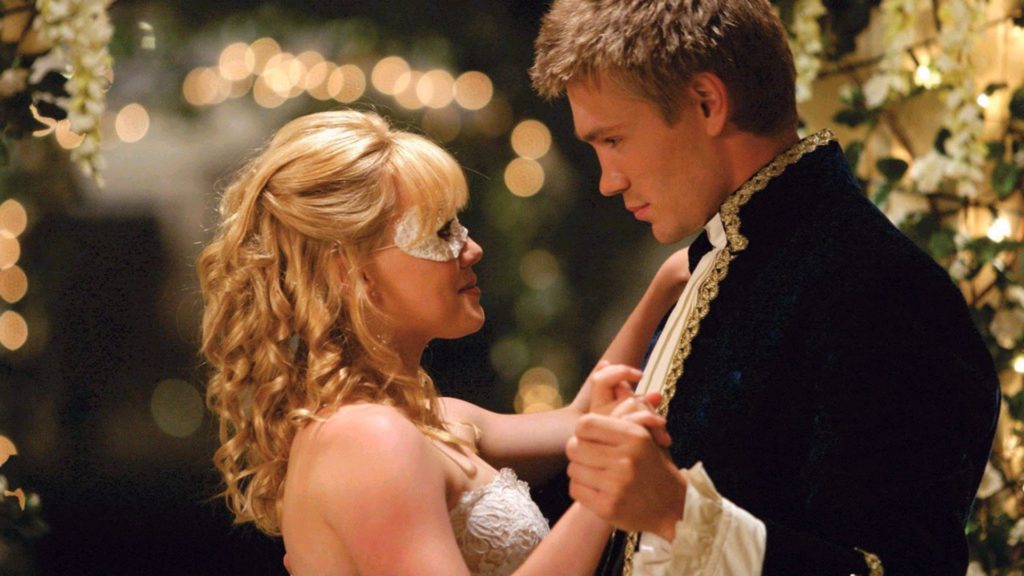
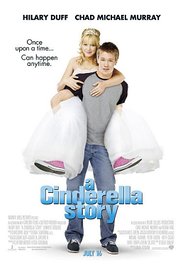 “Yay!!! I can finally write about all those chick flicks that my sisters and I watch any time on cable…Garry Marshall! Amanda Bynes! Selena Gomez! Hilary Duff! These are all names I don’t normally get to write about and now get to choose from!”
“Yay!!! I can finally write about all those chick flicks that my sisters and I watch any time on cable…Garry Marshall! Amanda Bynes! Selena Gomez! Hilary Duff! These are all names I don’t normally get to write about and now get to choose from!”
—The real, documented response of this very professional critic upon learning this month’s Admission topic
Yes, it’s true—even film critics have their guilty pleasures. Or, in my case, the shameless pleasures known as chick flicks. (My apologies to Nancy Meyers for using the loaded term.) Since my love for Garry Marshall has been well-documented, I think it’s time to admit there’s a reason 2004’s A Cinderella Story still holds its perpetual afternoon cable slot, and that’s because Freeform, Oxygen, and MTV all know I will turn it on every time they air it.
Fresh off her run as the Queen of Disney Channel, Lizzie McGuire (a show I watched devotedly growing up every time my family stayed in a hotel room with cable), Duff plays Sam, an L.A. high schooler. After her father dies inexplicably in an earthquake, her vain stepmother and “out-of-step sisters” force her into the attic and treat her like a servant at home and at the family diner. A social outcast, the only thing that makes her smile is her relationship an anonymous boy at her school she met in an online chat room. (Helloooo, 2004!)
From there, it’s a Cinderella story—with a few twists, of course. Her instant messaging prince turns out to be the most popular guy in school! The royal ball is actually the school’s Homecoming costume dance! The glass slipper she leaves behind is actually her flip phone! (Helloooo, 2004!)
I think it’s time to admit there’s a reason 2004’s A Cinderella Story still holds its perpetual afternoon cable slot, and that’s because Freeform, Oxygen, and MTV all know I will turn it on every time they air it.
When I saw this movie in the sixth grade, I swooned over ‘00s hunk Chad Michael Murray (a flagship star of the WB’s then primetime lineup in One Tree Hill) and cried when the most popular girl in school humiliates Sam with a cruel prank. But the real winner of this chick flick is Jennifer Coolidge, who plays evil stepmother Fiona. She goes so big with this materialistic, narcissistic role that she steals any scene she’s in. No matter your take on the rest of the film, I dare you not to laugh when she explains her recent Botox injection won’t let her “emotion for another hour-and-a-half.” The entire A Cinderella Story package might be my comfort food, but I’ll bet Jennifer Coolidge could crack a smile in even the most fairy tale-averse of the rest of you.
Irreversible
(2002, 120 Films, dir. Gaspar Noe)
by Paul Hibbard

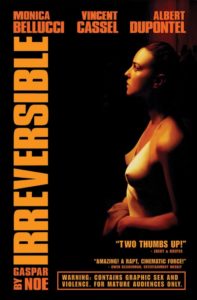 Irreversible is a movie that may not be the perfect fit for this article, but I still I think it warrants a nod and any time I can talk about it, I jump on that opportunity. It is a movie that has a favorable rating on Rottentomatoes, though slightly, but is generally hated by those who dislike it to the point that it helps taint the image of the film.
Irreversible is a movie that may not be the perfect fit for this article, but I still I think it warrants a nod and any time I can talk about it, I jump on that opportunity. It is a movie that has a favorable rating on Rottentomatoes, though slightly, but is generally hated by those who dislike it to the point that it helps taint the image of the film.
Those who hate it will agree that it is technically well made, but the debate around the film centers on director Gaspar Noe’s intentions. And to make it simpler, is it a good or evil film?
Some critics definitely say evil. That it is violence to justify violence and a faux revenge plot thrown in so people can leave feeling on the right side of morality, but also able to see some sick stuff. A lot of films do that, but I contend Irreversible’s views on violence are justified for two reasons.
The bait and switch of emotions between those two scenes was one of the most brilliant things I had seen at that point of my film-watching life.
Firstly, the switch in emotions you feel from the opening scene, when Marcus (Vincent Cassel) and Pierre (Albert Dupolent) hunt down a random guy in a bdsm club and bash his head in with a fire extinguisher. A sickly violent scene (that was the inspiration for the elevator scene in Drive), that makes you feel these guys are the villains of the movie you are about to watch. But then with a spin of the camera, we are now in the prior scene, where the two are driving around and looking for the club. Then another spin puts us in the scene before, and that backwards trajectory is how the film is told.
Irreversible is known primarily for the ten minute rape scene. And when the movie gets to that point, and you watch it being done by the man whose head is smashed in, you now view the opening scene, that forty minutes ago made you feel sick, as the only solace to get you through it. The bait and switch of emotions between those two scenes was one of the most brilliant things I had seen at that point of my film-watching life.
And secondly, the moment that solidifies the film as being brilliant is the end and Noe’s comments on man. The fact that the movie keeps spinning backwards, even after the rape that triggered everything. At this point, we are beyond a revenge plot and on a journey with a filmmaker who is saying that the violence that started in these characters did not start that night, but rather at the same time it started in us all, at the beginning of time and the inception of life.
Clue
(1985, Paramount Pictures, dir. Jonathan Lynn)
by Justin Mory
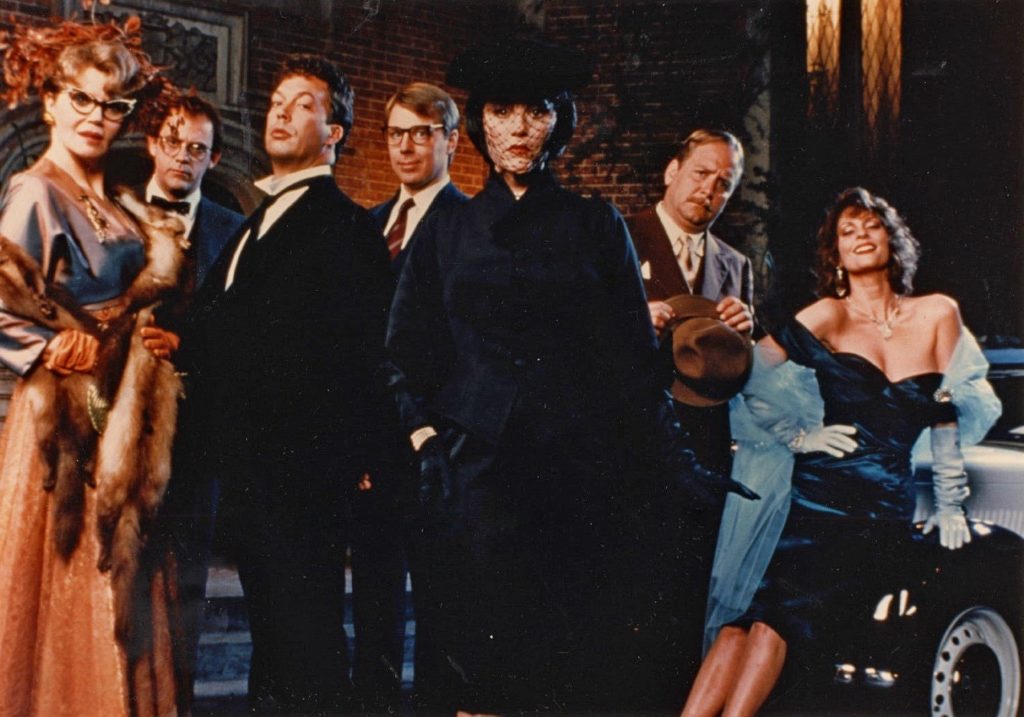
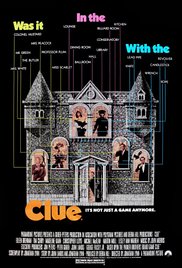 In his 1981 book Cult Movies, and two sequel books that followed in 1983 and 1988, critic Danny Peary offered 50 highly individualistic “viewings” of 50 highly eclectic movies that, for whatever reason, had been overlooked in their original release but had subsequently elicited a tremendous response from a small but fiercely dedicated group of appreciators. The odd part of the “cult” phenomenon, especially after Peary championed, dismissed, or offered differing views on films as varied as the 1947 film noir Out of the Past (championed), the 1971 acid head-trip Spaghetti Western parody El Topo (dismissed), or the infamously inept 1956 horror science fiction saga Plan 9 From Outer Space (ingeniously defended in a way that still has my critical head spinning), is that the conversation around many of these movies is still going strong 35 years later. The act of viewing a highly personal film becomes a creative act in and of itself.
In his 1981 book Cult Movies, and two sequel books that followed in 1983 and 1988, critic Danny Peary offered 50 highly individualistic “viewings” of 50 highly eclectic movies that, for whatever reason, had been overlooked in their original release but had subsequently elicited a tremendous response from a small but fiercely dedicated group of appreciators. The odd part of the “cult” phenomenon, especially after Peary championed, dismissed, or offered differing views on films as varied as the 1947 film noir Out of the Past (championed), the 1971 acid head-trip Spaghetti Western parody El Topo (dismissed), or the infamously inept 1956 horror science fiction saga Plan 9 From Outer Space (ingeniously defended in a way that still has my critical head spinning), is that the conversation around many of these movies is still going strong 35 years later. The act of viewing a highly personal film becomes a creative act in and of itself.
It is, in my opinion, genuinely funny, though I can entirely understand why some would find all the frantic door-slamming, key-hurling, corpse-dragging, and secret passage-creeping a tad wearying.
My choice is no classic, making my appreciation somewhat unusual considering I both agree with the critics who have dismissed it and disagree with its legion of admirers (of which I must count myself among) who defend it thus, so I feel my undying love of this farcical mid-80s drawing room murder mystery parody, based on a popular board game, must meet the criteria of a “guilty pleasure”. Clue (or as it was known in some promotional materials, Clue: The Movie) has a fantastic cast, evocative mid-50s period setting, a flawed though ingenious script, and one of my favorite movie scores in John Morris’s mock-menacing, screeching strings. It is, in my opinion, genuinely funny, though I can entirely understand why some would find all the frantic door-slamming, key-hurling, corpse-dragging, and secret passage-creeping a tad wearying.
What I think draws me back to this movie time and again is the same reason I equally loved Choose Your Own Adventure books as a tender lad. Like the board game it’s based on, everyone is a suspect, anywhere is a possible murder site, and any object a possible murder weapon. As in game-playing, uncertainty is built into the narrative of play as any choice reveals a different outcome. Released in theaters with one of three endings, and then released all together on home video, one feels in viewing that all outcomes are possible, and that each color-coded pawn of play – from Miss Scarlet (Lesley Ann Warren) and Mrs. White (Madeline Kahn) to Mr. Green (Michael McKean) and Professor Plum (Christopher Plum) – is equally guilty, despite whatever final outcome one happens to view, or whomever randomly adds to the rapidly mounting pile of corpses. Communism, famously, may be a red herring, but so too are the setting, characters, and of course the plot.
It’s like 96 sustained minutes of saying that even murder can be fun, that corpses can rise after being declared medically dead, and that butlers (who, by the way, always “done it”) are never to be trusted. With an always delightful Tim Curry (no stranger to these cult affairs, of course) as said butler, Wadsworth – presiding peerlessly over the three-story Gothic mansion, and its Charles Addams-by way of-Edward Gorey macabre doings – the game may end, but the video disc on my shelf always has a keen potential for re-play.
The Valley of Gwangi
(1969, Warner Bros.-Seven Arts, dir. James O’Connolly)
by Robert Hornak
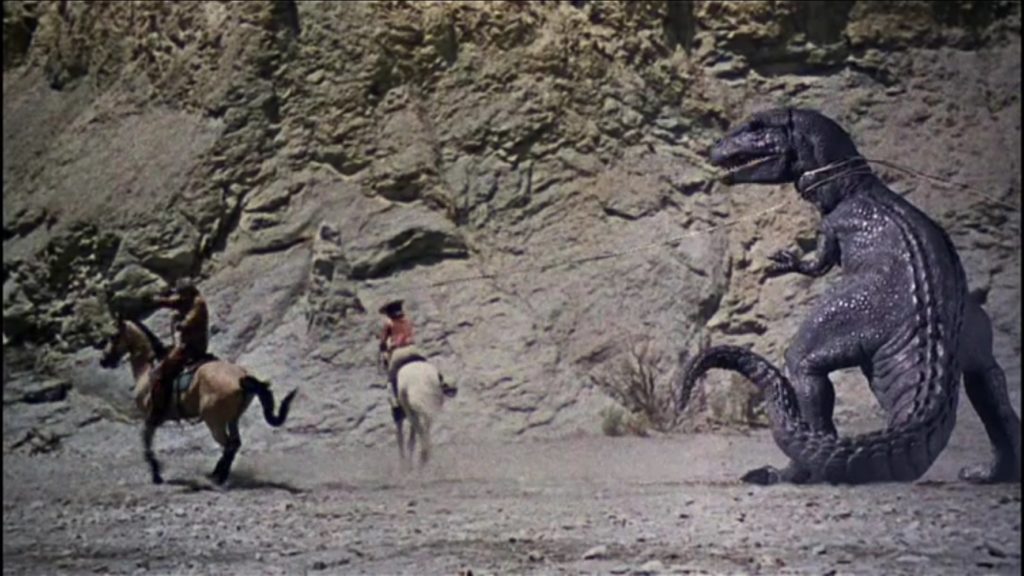
 For the uninitiated: Cowboys in 1900 discover a hidden valley lost in time, bring back a surly Allosaurus that destroys a small Mexican town and finally answers for its sins in a giant burning cathedral.
For the uninitiated: Cowboys in 1900 discover a hidden valley lost in time, bring back a surly Allosaurus that destroys a small Mexican town and finally answers for its sins in a giant burning cathedral.
Gwangi I put in my personal top five Ray Harryhausen movies. It’s two things. One, the irresistible conceit of putting dinosaurs in a cowboy movie, a sort of young boy’s dream mash-up. Two, its general underdog status. That is, of Harryhausen’s sixteen movies, it may be among his lowest-ranked. The reasons may not be debatable, objectively speaking: it’s not a crowd-pleasing mythological adventure like The 7th Voyage of Sinbad, Jason and the Argonauts, or Clash of the Titans, it’s not the most memorable of his monster-on-the-loose tales like Mighty Joe Young, The Beast from 20,000 Fathoms or even 20 Million Miles to Earth, and it only stacks up slightly against the epicness of his only truly great dinosaur movie, One Million Years BC. That one, released three years earlier, was a huge sensation, Hammer’s highest grossing movie, and a diorama of some of the greatest stop-motion dinosaur animation in film history. But an incoming, project-sweeping regime at Warner Bros.-Seven Arts shuffled Gwangi into side-B status with inappropriate double-bills (one was a biker movie), so it never reached its intended child-packed audience. It also failed miserably with critics, who by this point were expecting their westerns in the mold of The Wild Bunch and Once Upon a Time in the West, not some throwback to one-dimensional oaters from the previous decade. Or maybe it was just glum nostalgia for the charms of his last movie – anyone could see that James Franciscus as a turn-of the-century, wild west scoundrel was not Raquel Welch in a fur bikini.
The absolute, kid-level fun of watching these two worlds – prehistoric monsters and turn-of-the-century horsemen – collide before your completely believing eyes, is matched by the adult-level understanding of the incredibly meticulous, nigh unto mad genius required to match all those real ropes with the fake ones attached to the one-foot-high stop-motion model.
None of this discounts Harryhausen’s achievement: over 400 stop-motion shots, all completed in just under a year, virtually by himself. He was driven to realize the project, abandoned decades before by his mentor, the late Willis O’Brien, the man behind Harryhausen’s own childhood inspiration, King Kong – this was a full-circle labor of love. Before this film, Harryhausen had pulled off some truly amazing visual stunts, notably the seven-headed hydra and the sword battle with seven living skeletons (both scenes from Jason and the Argonauts). But surely as great as those, though it’s a more subtle thrill, is the lassoing of Gwangi by cowboys on horseback. The absolute, kid-level fun of watching these two worlds – prehistoric monsters and turn-of-the-century horsemen – collide before your completely believing eyes, is matched by the adult-level understanding of the incredibly meticulous, nigh unto mad genius required to match all those real ropes with the fake ones attached to the one-foot-high stop-motion model. To our (sadly) grownup eyes, there’s an overall sense of fakeness, at the way the creature moves, at the somewhat flat presentation on our screen, but to our still-beating kids’ heart, there’s nothing like the wonder and sheer coolness of this idea, executed to the maximum of what was allowable at the time, special effects wise. That visual alchemy is a joy you simply can’t convince me isn’t worth still shamelessly embracing. And I will continue to do so until I myself stop motion.
Vanilla Sky
(2001, Paramount Pictures, dir. Cameron Crowe)
by Erik Yates
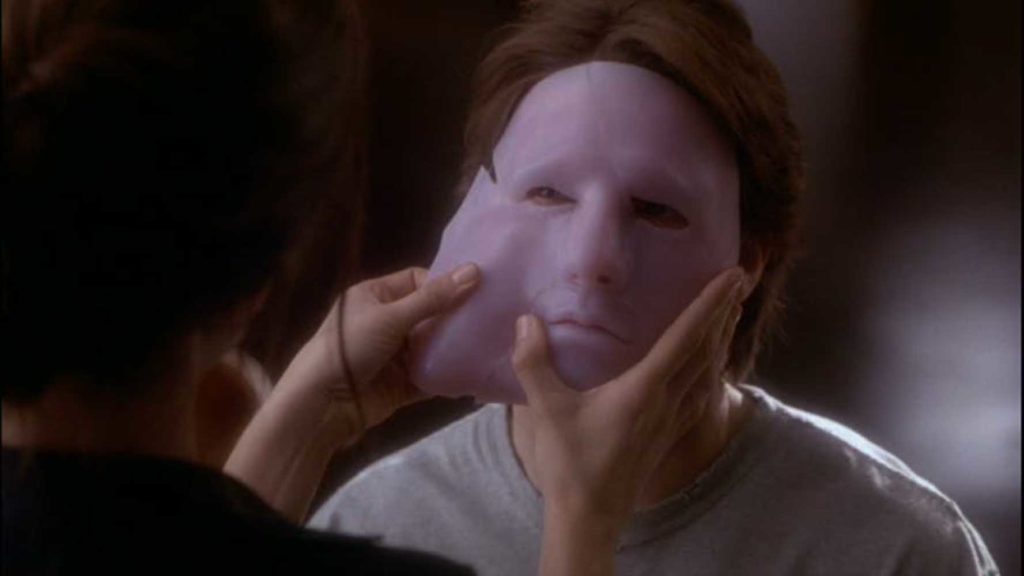
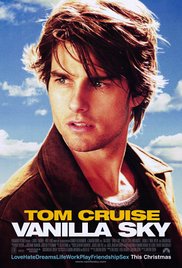 Before Tom Cruise jumped on Oprah’s couch or was lampooned by South Park over his Scientology beliefs, he was Tom “freaking” Cruise. Nearly every film was a hit. His previous film with director Cameron Crowe, Jerry McGuire, was a huge success, and a refreshing film for Cruise where he didn’t have to carry it like he would a huge blockbuster…though he still ran in the film per his contract, apparently. Cruise, had bought the rights of Alejandro Amenábar’s Abre los ojos (Open Your Eyes) and had invited Crowe over to view the film at his house where they discussed remaking it. The result was Vanilla Sky.
Before Tom Cruise jumped on Oprah’s couch or was lampooned by South Park over his Scientology beliefs, he was Tom “freaking” Cruise. Nearly every film was a hit. His previous film with director Cameron Crowe, Jerry McGuire, was a huge success, and a refreshing film for Cruise where he didn’t have to carry it like he would a huge blockbuster…though he still ran in the film per his contract, apparently. Cruise, had bought the rights of Alejandro Amenábar’s Abre los ojos (Open Your Eyes) and had invited Crowe over to view the film at his house where they discussed remaking it. The result was Vanilla Sky.
While it did receive some praise, it also received a lot of criticism. But, if I have to admit something, it is that I love this film. It may be in my top five all time. What worked for me was a combination of things, that I think ultimately cement it in my mind as a great film, and that it is also superior to the source material, which featured Penélope Cruz in the same role for both films. First, it is a complicated mind-bending film that delves into morality, belief, mental illness, narcissism, science, fear, love, sex, money, power, and countless other things. Couple that with Cameron Crowe’s genius when it comes to music and how the right song can influence the scenes, or color the mood just right, and it just worked.
Crowe’s use of music isn’t spoken of much these days with the likes of James Gunn or Edgar Wright using soundtrack music so well, but Crowe’s been doing it for 30 years and is the best at it. Just look at the way he redeems The Beach Boys’ “Good Vibrations” from being a commercial jingle to being a scary psychedelic catalyst to the film’s big reveal, as Tilda Swinton explains to Cruise’s David Ames what is actually happening to him, and you’ll see what I mean. Todd Rundgren’s “Can We Still be Friends” takes on extremely sinister overtones and titles like R.E.M.’s “Sweetness Follows” and Radiohead’s “Everything in its right place” give dark directions to where David finds himself. Crowe also introduces many to the music of Sigur Rós in this film.
The layers of clues Crowe provided in his film continue to yield results all of these years later.
I see Vanilla Sky as a visual tribute where its form is in the spirit of The Beatles’ “Revolution No. 9”, which Crowe has supported in interviews, as it is chocked full of so much chaos and mayhem spinning around before settling into the quiet ending much like on The White Album where “No. 9” segues into the lullaby “Goodnight”. That’s not to mention all of the references to “No. 9” throughout the film. Throw in lots of musical Easter Eggs like driving by The Dakota, where John Lennon lived and outside it was shot, to one of the big scenes in David’s lucid dream being a take on the Bob Dylan’s classic album cover “The Freewheelin’ Bob Dylan”. Throw in so many song references and lines in the film about dreams and you’ll have fun discussing what is real and what isn’t long after the film is over. Finally, for those of you who like Cameron Crowe, you will know that he loves the films To Kill a Mockingbird, The Apartment, Jules et Jim (Jules and Jim) and A bout de soufflé (Breathless) which are both connected with Francois Truffaut.
Paul McCartney wrote and performed the title song to further The Beatles connection, and there are countless nods throughout the film to the previous film Crowe did, Almost Famous (his best film), most notably the inclusion of Jason Lee, and Noah Taylor (also look for other members of Stillwater to show up). I haven’t even mentioned all of the many images one could look for as Tom Cruise runs through Times Square or as he falls off the final building. While many might prefer their films to have obvious endings and resolutions, Vanilla Sky leaves it open to the viewer to debate and argue about what they saw. The layers of clues Crowe provided in his film continue to yield results all of these years later. This makes the whole experience even sweeter, even when others dismiss it because they are sour on Cruise, the mind-bending nature of the film itself, or because it was released in the wake of 9/11 and never found traction. Either way, Vanilla Sky is a beautiful canvas of a film that gave Cameron Crowe a chance to stretch his wings from his normal romantic, dare-to-be-great stories, and push himself into a different genre with common themes from his other work still at its core. I wish he’d try that a little more.
Transformers: The Movie
(1986, Sunbow Productions, dir. Nelson Shin)
by Jim Tudor
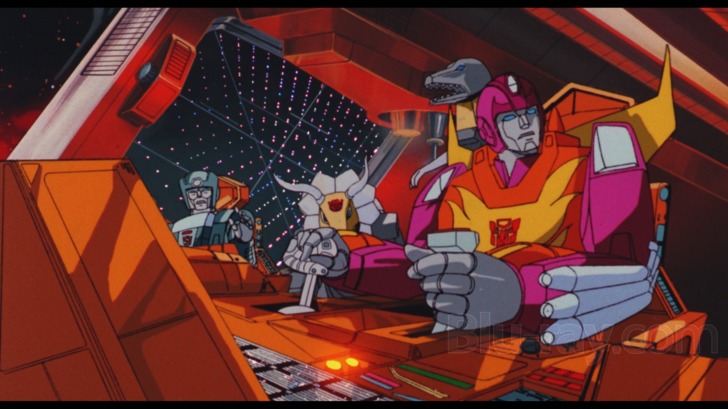
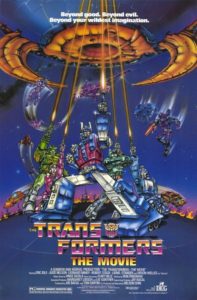 In the summer of 1986, I wasn’t supposed to be interested in toys anymore. I was heading into junior high school, leaving most of my friends behind, and not wanting any of that. I also had a mouth full of heavy metal, and still very much loved collecting G.I. Joe and Transformers toys. I simply was not ready to stop living in those worlds. At that age, I understood the juvenile conceits of the daily animated shows based on these Hasbro properties (I.e., no one dies), but didn’t care. I would defy the clock, defy what’s cool, and defy what’s age-acceptable for a thirteen year old boy.
In the summer of 1986, I wasn’t supposed to be interested in toys anymore. I was heading into junior high school, leaving most of my friends behind, and not wanting any of that. I also had a mouth full of heavy metal, and still very much loved collecting G.I. Joe and Transformers toys. I simply was not ready to stop living in those worlds. At that age, I understood the juvenile conceits of the daily animated shows based on these Hasbro properties (I.e., no one dies), but didn’t care. I would defy the clock, defy what’s cool, and defy what’s age-acceptable for a thirteen year old boy.
Then Transformers: The Movie came and blew it all up. Thankfully, it blew it up in a good way. (Look no further than Michael Bay for how Transformers movies can blow it up in a bad way). This was not the first attempted theatrical cash-in on a current kids show, but it proved to be the only one worth remembering. In under ninety minutes, long-standing familiar characters were indiscriminately killed off, and a whole new cast and status quo was ushered in. “It is the year 2005…”, the opening narration informs us. Things had gotten decidedly more brutal in the Transformers universe in twenty years. Early in the film, noble Autobot leader Optimus Prime famously dies in battle. With him goes the more innocent, more contained and casualty-free Earthbound adventures of these relatable characters. From here on, it would be darker psychological and even political adventures on the daily series. But none of that ever nailed the adrenalized heights of Transformers: The Movie. It’s a wonder what a big screen canvas and a PG rating can allow for.
It does what it does deceptively well, with an uncanny sense of pushed dynamism.
Following my initial awe at the considerably improved quality of the animation, we soon got the wildest of opening titles, set to the loudest, most shredding version of the Transformers TV theme imaginable. Leonard Nimoy as Galvatron. Eric Idle as Wreck-Gar. Fast-talking John Moschitta as Blurr. And… can this be right…? Orson Welles as Unicron! Wait a minute, who are all these characters, anyway? Who cares! This is awesome!
And the soundtrack… “Weird Al” Yankovic is there, whom I was already very much on board with. The rest of the songs (and there are several) alternate between overtly positive 1980’s power anthems and searing heavy metal, giving the crazy braces in my mouth a run for their money. Neither musical style has been my forte, but in this context, I was enraptured. I was a good kid, never looking for trouble. But yes, this would indulge my inner rebel just splendidly.
The notion that suddenly, everything is changed and a monstrous mechanical planet-eating-planet is threatening your very existence spoke to me, loud and clear. So did the emergence of the teenage Autobot Hot Rod, voiced by Judd Nelson. With the respectable but square red white and blue Ultra Magnus the obvious new goodguy leader, it was a downright Campbell-ian shock that it turns out Hot Rod is the new main man. Destiny is full of twists. Sometimes it’s up to the nobody on the fringes to step up and make things right. (Check the film’s poster – Hot Rod technically isn’t even on it.)
These days, there’s plenty of love for Transformers: The Movie – much of it ironic. I know that we’re supposed to scoff at the overwrought dialogue, synthesizer music and songs like “The Touch” and “Dare”. (See Boogie Nights and GLOW, respectively). But I never will. I know better than to take it too seriously, but I do deeply love this goofy movie. I don’t live in the worlds of G.I. Joe and Transformers anymore, even though pop culture certainly now allows and encourages it of all ages. (Unthinkable in 1986, I must say!) But I love to revisit this one every few years. It does what it does deceptively well, with an uncanny sense of pushed dynamism. It’s full of details, characters and visions I will always carry with me. Transformers: The Movie is, in no uncertain terms, the movie that got me through junior high. And it continues to inspire.
Austin Powers In Goldmember
(2002, New Line Cinema, dir. Jay Roach)
by Krystal Lyon

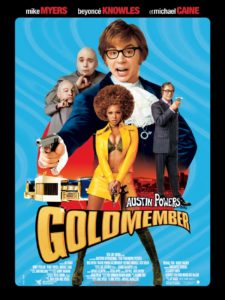 I wish this review could be a video of me and my friends Anna and Alexis watching Austin Powers In Goldmember. You would hear us quote most of the film and laugh constantly through it. Then you would understand why I love it so, the joy would be overwhelming.
I wish this review could be a video of me and my friends Anna and Alexis watching Austin Powers In Goldmember. You would hear us quote most of the film and laugh constantly through it. Then you would understand why I love it so, the joy would be overwhelming.
Austin Powers In Goldmember is my choice for this month’s Film Admission because it’s on my top ten list of favorite movies, and whenever I tell anyone that, I get the “you’re kidding me” look. Friends don’t doubt the comedic genius of Mike Myers, nor the hilarious spoof on the Bond franchise, but they doubt Goldmember itself. Here are some samples of what I hear, “It’s obviously not as funny as the first two installments” and “it’s just the same jokes over and over again.” So I am pumped that for the next couple paragraphs I get to sing the praises of this knee slapper.
It’s not complex, but the easy jokes and silliness are genius to me.
If you’re not familiar with the Goldmember plot here are the basics. Dr. Evil (Mike Myers) has joined up with Goldmember (Also Mike Myers), Mini Me (Verne Troyer) and his other criminal cohorts and they’ve kidnapped Austin Powers’ farger (father in freaky deaky Dutch and played wonderfully by Michael Caine). Austin (yet again Mike Myers) teams up with “Whole Lotta Woman” Foxxy Cleopatra (Beyoncé) to find his father and save the world. But Austin has some daddy issues that he needs to figure out before he can rescue his father or the world. It sounds like a simple plot, and it is, but Myers fills in all the gaps with comic treasures. For example Goldmember who “likes to paint men’s yoohoos gold, It’s kinda his thing.” In the 1970s, he accidentally lost his genitals in an unfortunate smelting accident. Myers is playing with the Bond classic Goldfinger (which I just watched for the first time last August for our Film Admission on Sean Connery) and it’s delicious. Every line is a pun, joke or reference to another film which for me leads to constant laughs. It’s not complex, but the easy jokes and silliness are genius to me.
I think that comedies are underrated and overlooked. It’s not easy work making people laugh which is a sad state. We have enough drama and monotony in our days, a little over-the-top hilarity is needed every once and a while. And Austin Powers In Goldmember is a fun break for our brains, it’s the movie equivalent of going to a fun house or goofy filters on Snapchat, simple and silly. Haters go ahead and hate but I love this movie for the memories with dear friends and for the fact that 15 years and who knows how many watches later it still makes me laugh more than any film. “So stick that in your pipe and smoke it, this is for all my homies in Bruges!”

